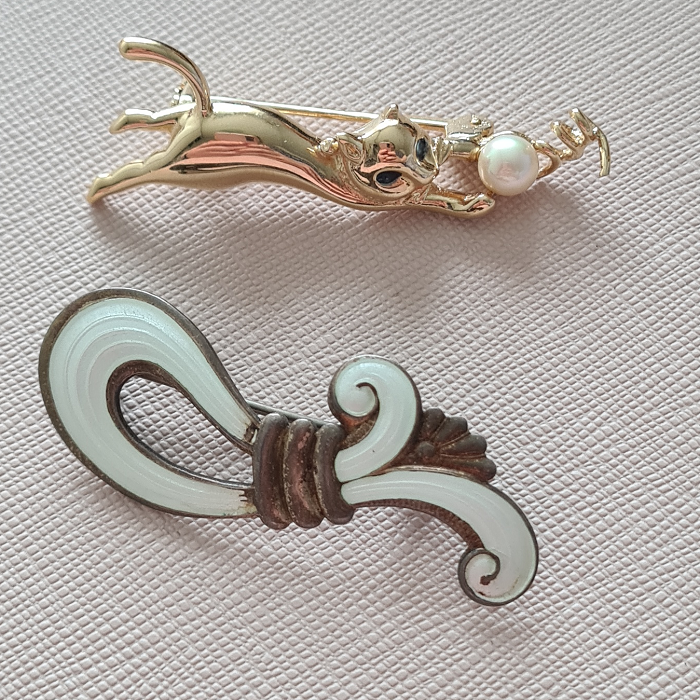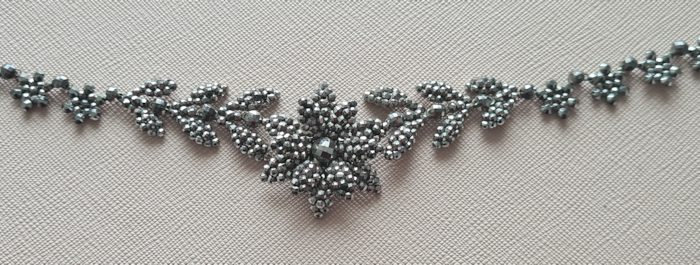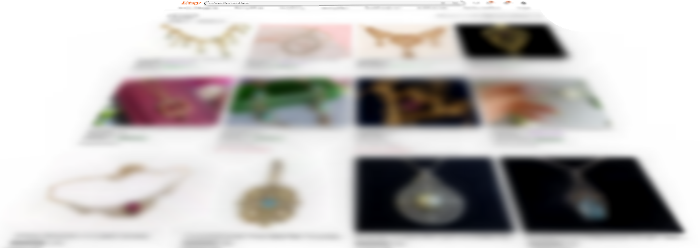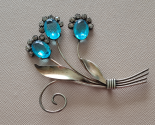
Gold and gold plate
While not all that glimmer is gold (some of it may be pinchbeck, tombac or some other base metal alloy), even what is perceived to be gold, may not be all that precious. Let’s go through some phrases you may come across that include the word “gold”, and what they actually mean.
Gold alloys – fineness and colour
9 ct to 24 ct gold
Carat (ct – in the UK, elsewhere carat is only used as a measurement of weight) or karat (k) tells us about the fineness of the gold, with the number indicating how many 24ths of the alloy is made up of pure gold. 24 ct is pure gold, and is too soft and malleable to be useful. Shopping for jewellery, you will come across a lot of different carats, from as low as 3 to as high as 22. Today, 14 ct and 18 ct are the most common, while 8 ct and 9 ct are used for more inexpensive jewellery. Within the EU, alloys below 9 ct cannot be referred to as gold. The fineness does of course influence the value, and it may also tell us something about the age and nationality of the piece of jewellery. You can read more about fineness here.
Yellow gold
Yellow gold is the most common gold alloy. Pure gold is yellow, and when making a yellow gold alloy, the goal is to keep that golden hue, or modify it slightly. Depending on the amount of gold, mixture of other metals and the fashions of the time, yellow gold may appear almost greenish (if it’s actually green, it’s green gold, which is its own thing), vibrant yellow or with a slightly reddish tinge. The remainder of the alloy that is not gold (which of course varies depending on the fineness of the alloy) will usually be made up of about 50/50 copper and silver (for modern 14 ct yellow gold, 58.5 % is gold while 25 % is usually silver and 16.5 % copper).
Red gold, rose gold and white gold
There are several kinds of reddish gold alloys, and sometimes, it can be tricky to differentiate between a reddish yellow and a weak pink gold. The difference, both between pink, rose and red, and between them and yellow gold, lies in the amount of copper and the presence of silver. Copper lends the alloy redness while silver partly neutralises it, so a larger percentage of copper compared to silver will turn the gold red.

White gold looks a lot like silver, but may have a slight yellow tinge to it. Today, most white gold is plated with rhodium to make it silvery white (the same metal is sometimes used on silver to keep it from oxidising), but this plating can be worn off and will need to be repeated. Creating white gold require the addition of a white metal to the alloy, which will usually be either silver, nickel or palladium. Copper may still be added, and sometimes zinc and platinum too. Commercially available white gold is a fairly new occurrence, hailing from about 1920, so if you come across a piece of Edwardian jewellery in white gold, you’re probably being misled.
Bloomed gold
Bloomed gold was in its heyday in the mid-Victorian era, and involved dipping a piece of gold jewellery into a chemical bath that would render the surface slightly textured with a satiny sheen.
Gilding and golden sandwiches
When gold is added on top of another metal, it’s gold plated. However, there are many different kinds of gold plate, some more sturdy than others. Note that the metal below the gold may actually be gold too!
Gold-plated
Electroplating of gold was invented in the 1840s (the first patents were given to George and Henry Elkington in 1840), and replaced the dangerous practice of fire-gilding with mercury. The jewellery is made from one metal and then coated with 24 ct gold by means of an electrical current, depositing a thin layer of gold on top of it (electroplating is done to a lot of different metals). Gold-plating may be done on a base of copper, silver or even gold – in the latter case, it will be done to give extra sheen and even the tint of pure gold to a lower-carat piece. Electroplating uses the least amount of gold, and thus the lowest value compared to other kinds of plate. It is more likely to flake off or be rubbed off during cleaning over the years.
The French word vermeil is used for Sterling silver objects coated in a layer of at least 2.5 micron gold that is at least 15 ct.

Rolled gold
Rolled gold is made of a layer of base metal (usually copper, but sometimes brass or silver) sandwiched between two thinner layers of gold, and was patented in England in 1817 (there may also be just one layer of gold over a base metal). It would be used for costume jewellery or what could perhaps be labelled as “semi-fine jewellery”, meaning quality jewellery with a modest price point, set with pastes or semi-precious stones. It was also widely used for mass-produced items like lockets during the Victorian era.
Antique pieces of rolled gold should be marked as “gilt” or with a stamp indicating that it is rolled and what carat the gold layer is. Gold-filled and gold-cased are basically the same, although the methods and amounts of gold used vary. All of them will likely keep their charm for decades, but since the layer of gold is relatively thin, it is likely to wear off eventually, and they may not make the best investments for an antiques collector.
Silver over gold
Silver over gold is the opposite of gold plating. Before white gold was commercially available, jewellers would sometimes plate certain parts of a piece of gold jewellery in silver, usually in order to make diamonds pop; adding a few diamonds on a silvery background will help tricking the eye into believing there are more or bigger diamonds present, and this trick is still carried out today, albeit usually with white gold rather than silver. Remember that silver over gold will tarnish, and that removing that tarnish in time will lead to the silver being rubbed off entirely.
Avoid being tricked
There is no shame in liking something that is not gold all the way through, but nobody likes being fooled. There is quite a lot of gold plate out there, and since a smaller percentage is pure gold, it is worth less than a comparable piece that is gold throughout. Look for wear and dents where the gold would be worn off, were it a plated item – if you see the warm glow of copper or the pale sheen of silver behind the gold, you know you’re dealing with gold plate, and it should be valued accordingly.

Depending on the age and origin of the piece, it may include a stamp giving the carat of the layer of gold followed by either H.G.E, R.G.P. or G.F, abbreviations for heavy gold electroplated, rolled gold plate and gold filled. Note that different countries have different rules for how gold plate should be marked, so you may for instance come across golden pieces marked as 925 (i.e. electroplated Sterling silver) or AmDbl (rolled gold). While worn-off rolled gold cannot be fixed, a new round of electroplating may be an option, depending on how the piece is made. This will be most easily done on items with no stones and a uniform colour.







-
-
3 years
Tagged alloys, georgian, pinchbeck